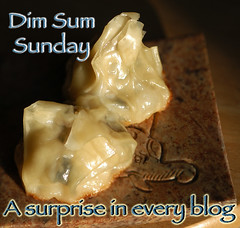Perhaps it would be easier if we started with people who are not Americans to give us their impressions of what American food is. The French, I suspect, would proclaim we are no better than our global McDonald's offerings. Sour pommes frites, mon amis? Our French foodie brothers might have a point though. I certainly wouldn't want the world to think that the Big Mac represents the depth and breadth of our gastronomic identity.
 So, if we are not the Big Mac, what are we? What is our representative food? Could it be as simple as Thanksgiving Dinner? (U.S. turkey farmers would certainly like that!) A meal quintessentially American - Turkey, stuffing, mashed potatoes and gravy, green beans, cranberry sauce and pumpkin pie. But is that all we are? A roasted bird, some boiled and mashed tubers, over-cooked vegetables, candied, jellied fruit and a custard based pie? I think not. In fact, that's not even an accurate portrayal of food served at first Thanksgiving, with the possible exception of the turkey. (And the turkey of today is a buxom, genetic freak when compared with the wild turkeys of the 1620s!)
So, if we are not the Big Mac, what are we? What is our representative food? Could it be as simple as Thanksgiving Dinner? (U.S. turkey farmers would certainly like that!) A meal quintessentially American - Turkey, stuffing, mashed potatoes and gravy, green beans, cranberry sauce and pumpkin pie. But is that all we are? A roasted bird, some boiled and mashed tubers, over-cooked vegetables, candied, jellied fruit and a custard based pie? I think not. In fact, that's not even an accurate portrayal of food served at first Thanksgiving, with the possible exception of the turkey. (And the turkey of today is a buxom, genetic freak when compared with the wild turkeys of the 1620s!)
Let's ask our government officials. Can they give us a clearer picture of our food as a whole by looking at the state food of oh, let's say Maryland. Their state food is the blue crab. Certainly works for me, being a native Marylander and all. But how would that fly with the good folks in Oklahoma who list biscuits and gravy, chicken fried steak...
 ...and fried okra as their state menu. (The bigger the state, the more items you're allowed? Can't wait for Alaska to check in...) And Oklahoma wasn't satisfied with that roadside diner of a state menu. They went all crazy and declared the state vegetable to be the watermelon!! Perhaps asking the states was a mistake...
...and fried okra as their state menu. (The bigger the state, the more items you're allowed? Can't wait for Alaska to check in...) And Oklahoma wasn't satisfied with that roadside diner of a state menu. They went all crazy and declared the state vegetable to be the watermelon!! Perhaps asking the states was a mistake...No, I believe it's more personal. To each his or her own. My mom's fried chicken is just as good a representation of our national grub steak as your mom's lasagna. The tamales bought from the back of a station wagon are just as American as the vegetables purchased from the roadside stand. They all add to the pot.
To me our cuisine is very much like another uniquely American composite...jazz. How else could you explain Mario Batali's theme and variation on a ravioli (black truffles, beef cheeks, squab liver and anchovies) to the average Italian. Or describe to the Germans what Pink's has done their frankfurters? C'mon kids, we can't even agree what constitutes real barbecue in this country. We're not talking Escoffier here. Culinary basics that haven't changed in a hundred years. We're talking soaring heights and disastrous lows, riffs and runs on a culinary landscape that changes with every addition that newcomers bring to this country, pockets stuffed with recipes and ideas to add to our pot. Will Namibian food be a staple of the drive through lane in 50 years? Will kids come home from school and want a snack of khubaz while they do their homework? What new Frankenfusion will appear on the horizon only to become a gastronomic bookmark in our culinary memory?
Our diverse food DNA has many markers, most being adaptations of recipes from other countries that were added to our glorious melting pot by immigrants who were proudly assimilated into the mighty American borg. "American" food is an amalgam consisting not only of apple pie, but fajitas, hamburgers, and yes, even a bastardized version of pommes frites, "the french fry". So here's to the great American communal stock pot...may she always be bubbling!








4 comments:
Interesting. The migration of peoples, travel, and the migration of ingredients has had an impact on the cuisine of MOST Nations, including the 3 you cite, Germany, Italy and France. Was that impact more pronounced on American cuisine? Perhaps.
But it's worth mentioning that several regional American cuisines were borne out of pressures, isolation, and shortage.
Amish ( yummy) and Mormon (blech) cooking styles borne out of largely self-imposed isolation.
Southern (yummy but deadly) including barbecue borne out of war-imposed shortage and poverty.
And adapted from a cuisine that had been formerly the province of slaves.
Southwestern (true southwestern) borne out of geographic isolation, ingredient poverty and pressured by climate.
One could say a LACK of immigration of both people and ingredients spurs cooking creativity at times.
Great article Shamu, makes me glad to be living in NYC as I can sample so many different country's cuisines without having to travel outside of city lines.
I am all for ethnic cuisines being a part of the American landscape. Everyone who is here is a descendant of someone who came from somewhere else.
Troll I totally agree that the pressures of isolation and shortages had some influence on our national cuisine. But as much as the millions of immigrants that stepped foot on these shores and continue to arrive daily?
You did use a word that I think is even more important to American cuisine and that's adaptability. Taking a piece of beef that few use, cooking it in a way that makes it just as palatable as if it were a more expensive cut and have it become popular enough that people copy it and serve it commercially. Think fajitas. Adaptability will get you through food rationing, crop failures or geographic isolation.
Making lemonade out of lemons. It's the American way!
Jon, I know just how you feel about the wealth of ethnic cuisine choices. Growing up in the DC metro area and having the amazing luck of choosing from plethora of new and exciting food adventures is something I cherish.
Post a Comment